You’ll value authentic silver handcrafts by first checking hallmarks for purity stamps like “925” for sterling silver or “958” for Britannia silver. Examine the craftsmanship quality, artistic design complexity, and physical condition while researching the maker’s reputation through documented marks. Determine the piece’s age, rarity, and historical significance, then compare recent auction sales data with current dealer pricing to establish fair market value. Understanding these fundamentals will reveal deeper valuation strategies.
Understanding Silver Purity and Hallmark Identification
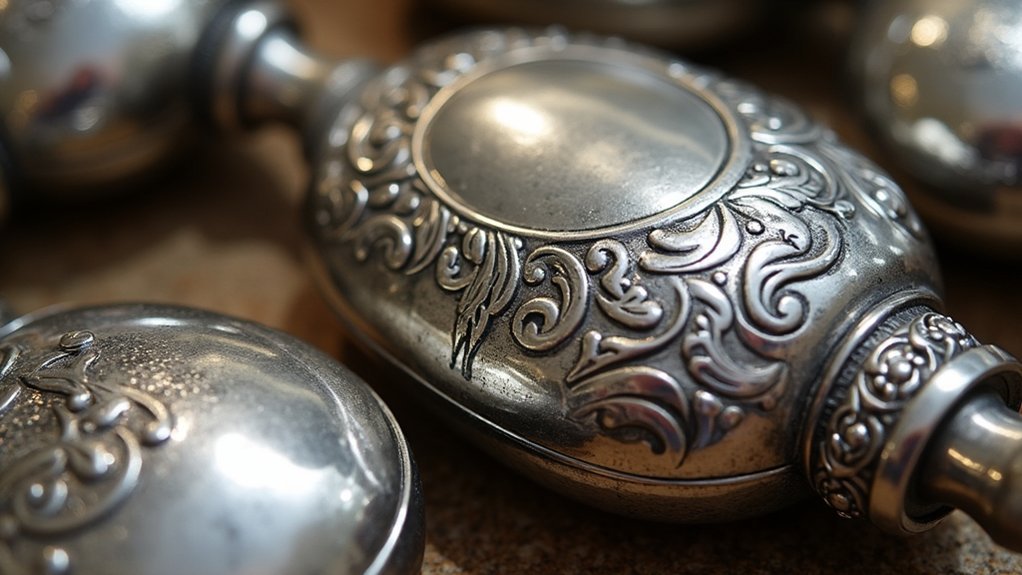
How can you distinguish authentic silver from clever imitations when evaluating handcrafted pieces? Start by examining silver hallmarks, which reveal the purity of the silver content. Look for “925” stamps indicating sterling silver with 92.5% pure silver content. Higher-value pieces may display “958” for Britannia silver, while European items often show “800” or “835” markings.
Don’t stop at purity marks alone. Authentic pieces feature maker’s marks alongside hallmarks, providing valuable information about origin and craftsmanship quality. However, you’ll need sharp eyes since counterfeit hallmarks from the 19th and early 20th centuries can fool inexperienced buyers.
Different countries use distinct hallmark systems, so familiarize yourself with regional variations. Accurate hallmark verification prevents costly mistakes when determining authenticity and establishing fair market value for handcrafted silver pieces.
Examining Craftsmanship Quality and Artistic Design
Beyond confirming authenticity through hallmarks, you must evaluate the artistic merit and craftsmanship that determine a piece’s true worth.
Examine the intricacy of designs closely—handcrafted pieces with unique artistic expression command higher values than mass-produced items. Look for traditional techniques like filigree or repoussé, which require exceptional skill and time investment.
Handcrafted silver with intricate filigree or repoussé work demonstrates superior artistry and commands significantly higher market values than mass-produced pieces.
Pay attention to artistic design styles such as Art Deco or Arts and Crafts, as collectors actively seek pieces representing specific movements. High-quality engravings and embellishments greatly boost both aesthetic appeal and market valuation.
Research the silversmith’s reputation and documented provenance, since renowned makers fetch premium prices at auctions. The craftsmanship quality ultimately reflects the piece’s historical significance and artistic legacy in today’s marketplace.
Assessing Physical Condition and Wear Patterns
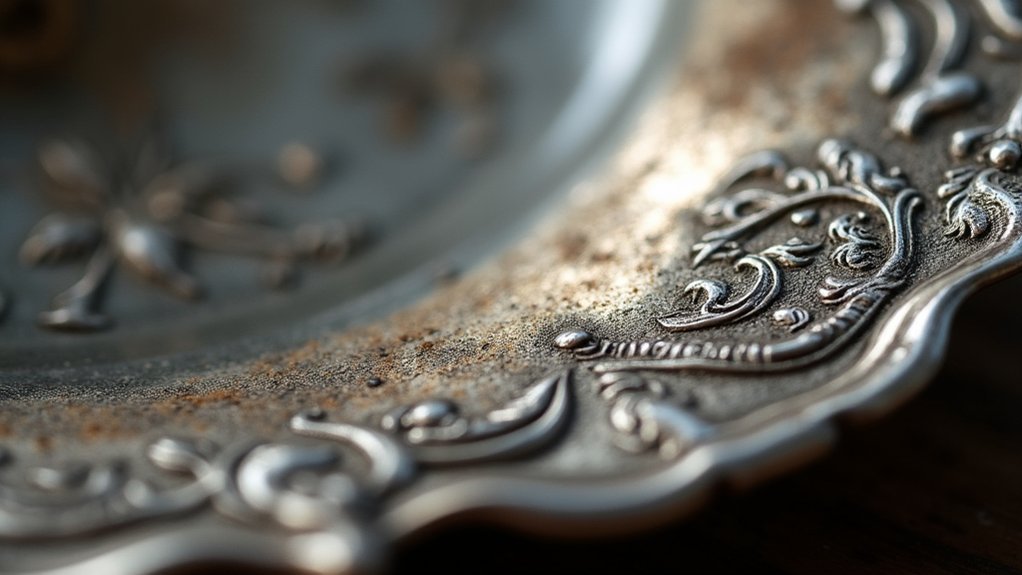
While artistic merit establishes a piece’s creative value, its physical condition directly impacts market price and collector desirability.
You’ll need to carefully examine every surface for dents, scratches, and tarnish that can greatly reduce value. Look for wear patterns that might indicate heavy usage – while these can suggest historical significance, excessive damage typically detracts from worth.
Focus on finding pieces with unaltered surfaces and minimal imperfections, as original condition is essential for accurate valuation.
Don’t overlook high-quality engravings, which can enhance value if they contribute to provenance or artistry.
Remember that regular polishing and proper maintenance can mitigate tarnish effects, helping preserve the piece’s physical condition and potentially increasing its market value over time.
Determining Age, Rarity, and Historical Significance
Although physical condition affects immediate pricing, a silver handcraft’s age, rarity, and historical significance determine its long-term collector value and market position.
You’ll find age through hallmarks indicating production year – older pieces typically command higher prices due to scarcity.
Examine rarity by identifying limited-edition items or works from renowned artisans, as these fetch premium prices.
Historical significance dramatically enhances value when pieces connect to notable events or figures.
You should prioritize items with documented provenance since authenticated ownership history provides certainty and context that collectors value.
Specific periods like the Arts and Crafts Movement increase desirability because they represent unique cultural movements.
These factors create lasting investment potential beyond simple aesthetic appeal.
Calculating Base Silver Value Using Current Market Prices
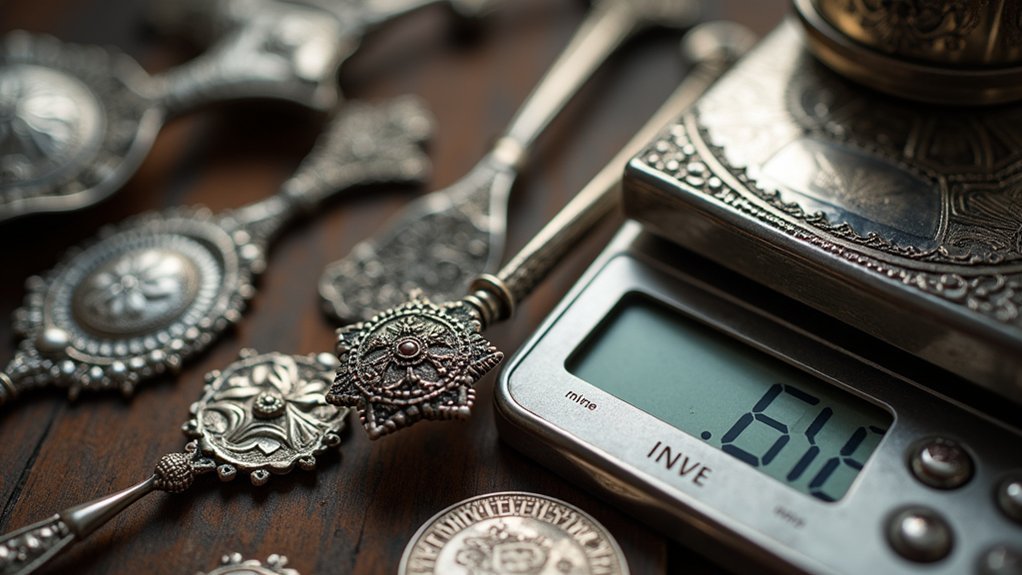
How do you determine the fundamental worth of your silver handcraft before considering artistic value?
Start by weighing your piece using a precise scale, ensuring measurements are in troy ounces, the standard for precious metals.
Next, confirm silver purity by locating hallmarks—”925″ indicates sterling silver containing 92.5% pure silver.
Research the current silver price on reputable financial websites, as spot prices fluctuate daily.
Apply this formula to calculate base value: Weight (troy ounces) × Purity (%) × Current Silver Price equals your item’s fundamental worth.
This base value represents minimum melt worth—the intrinsic metal value alone.
Researching Maker’s Reputation and Brand Recognition
Once you’ve established your piece’s base silver value, you’ll need to research the maker’s reputation to determine any premium above melt value.
Start by examining hallmarks and maker’s marks carefully, as these stamps reveal the silversmith’s identity and can greatly impact collectible worth.
Notable silversmiths like Georg Jensen, Tiffany & Co., or Paul Revere command substantial premiums, while lesser-known craftsmen may still add value if they’re regionally significant or possess exceptional skill.
Notable Silversmiths Throughout History
The legacy of master silversmiths echoes through centuries, with their names alone capable of transforming an ordinary piece into a coveted treasure.
When you’re evaluating silver handcrafts, recognizing these legendary artisans can greatly impact your assessment.
Here are four silversmiths whose names command premium prices:
- Paul Revere – American patriot whose distinctive craftsmanship makes his pieces exceptionally valuable
- Georg Jensen – Danish designer synonymous with modern silver excellence
- Thomas Germain – 18th-century French master known for intricate royal commissions
- Hester Bateman – English silversmith celebrated for elegant late 18th-century designs
You’ll find that renowned makers often command prices two to three times higher than lesser-known artisans.
Antique dealers consistently emphasize researching each silversmith’s historical significance and hallmarks to determine rarity and market value.
Hallmark Authentication Methods
Identifying these master craftsmen requires mastering hallmark authentication, a skill that separates novice collectors from seasoned experts.
You’ll need to research each hallmark thoroughly using online databases and specialized reference books that catalog silver marks by maker, country, and time period.
When examining sterling silver items, look for the “925” mark that confirms authenticity and metal purity. Cross-reference any maker’s marks with established silversmiths like Tiffany & Co. or Georg Jensen, whose reputations greatly boost market value.
Understanding the historical context behind each maker helps you assess their market presence and collector desirability. This research enhances your piece’s provenance, directly impacting its pricing potential and investment worth.
Evaluating Provenance and Documentation History
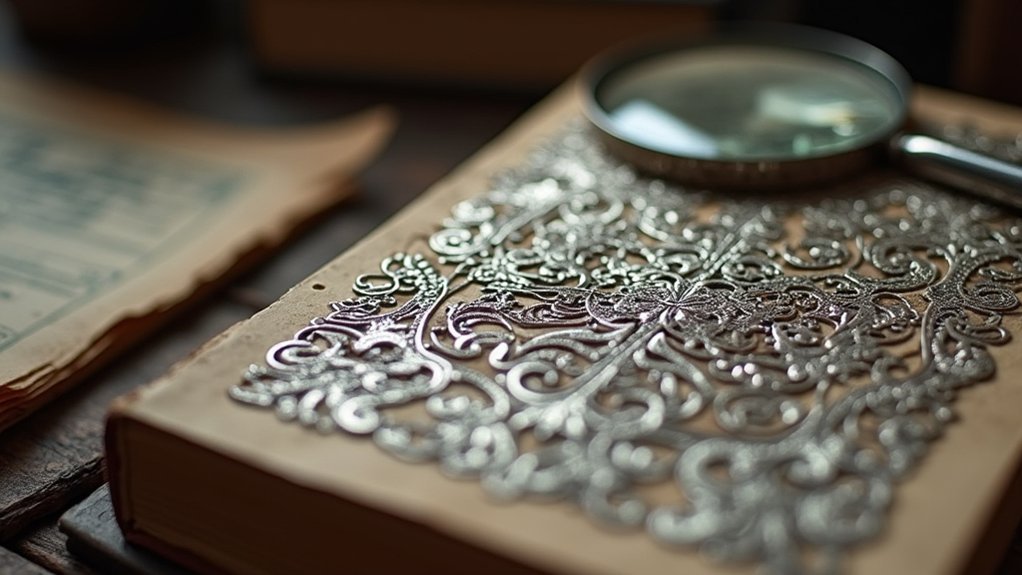
Why does a silver piece’s history matter as much as its craftsmanship? Provenance transforms an ordinary antique into a valuable treasure by documenting its journey through time.
A silver piece’s documented journey through time elevates it from ordinary antique to invaluable treasure through proven provenance.
You’ll find that auction houses consistently price items with strong documentation higher than similar pieces without clear histories.
When evaluating provenance, you should examine these critical documentation sources:
- Original receipts and sales records from previous transactions
- Historical photographs showing the piece in specific settings or with notable owners
- Expert appraisals and authentication certificates from recognized authorities
- Auction house records tracking the item’s sales history
Items connected to historical figures or significant events command premium prices.
You’ll discover that maker’s marks combined with solid documentation create the perfect storm for maximum value in today’s silver market.
Comparing Similar Pieces in Current Marketplace
You’ll need to examine online auction results to understand what similar silver handcrafts have actually sold for, not just their listing prices.
Compare dealer pricing across multiple reputable sources, as these professionals often have insight into true market value based on their experience with collectors.
Focus on recent sales data from the past six months, since older transaction records won’t reflect current market conditions or silver price fluctuations.
Online Auction Analysis
Three major auction platforms offer valuable insights when you’re researching comparable silver handcrafts in today’s marketplace.
You’ll discover the true value of sterling pieces by examining completed sales rather than current listings. Focus your analysis on these critical elements:
- Bidding patterns – Track how aggressively collectors compete for specific makers or styles.
- Final hammer prices – Compare identical or nearly identical pieces sold within recent months.
- Condition impact – Note price differences between pristine and damaged examples.
- Documentation quality – Observe how detailed descriptions and clear photos influence bidding.
Major auction house platforms like eBay, Catawiki, and Heritage Auctions provide extensive databases of finalized transactions.
You’ll gain deeper market understanding by studying hallmarks, craftsmanship quality, and regional preferences that drive competitive bidding behavior.
Dealer Price Comparison
While auction data reveals past market performance, current dealer listings provide real-time pricing intelligence that’s essential for accurate valuation.
When conducting dealer price comparison, you’ll discover how reputable dealers currently price similar authentic silver handcrafts. Contact specialized antique dealers who focus on silver pieces and inquire about their inventory prices for comparable items. This direct approach provides insights into current market trends and helps you understand the value of antique silver in today’s marketplace.
Compare your piece’s craftsmanship quality, design complexity, and maker’s reputation against dealer offerings. Pay attention to how dealers justify their pricing based on these factors.
You’ll often find that dealers price items higher than auction sales, reflecting their expertise, authentication services, and overhead costs, which helps establish your piece’s retail market value.
Recent Sales Data
Moving beyond current dealer offerings, examining recent sales data provides concrete evidence of what collectors actually pay for authentic silver handcrafts in today’s market.
You’ll discover that the value of silver extends far beyond base metal weight when exceptional craftsmanship’s involved.
Current marketplace analysis reveals these key pricing trends:
- Premium multipliers: Handcrafted pieces sell for 1.5 to 3 times their silver weight value
- Auction records: Exceptional antique silver pieces have reached $20,000+ at major auctions
- Unique advantage: One-of-a-kind items command 30-50% higher prices than mass-produced alternatives
- Market growth: Collector interest has driven average auction prices up 15% this year
Provenance documentation greatly impacts final sale prices, with historically significant pieces often doubling their estimated values when proper authentication’s available.
Recognizing Regional Hallmarking Systems and Standards
When you examine authentic silver handcrafts, you’ll quickly discover that hallmarking systems differ dramatically across regions, each reflecting centuries of local traditions and regulatory standards.
Regional hallmarking systems tell the story of centuries-old traditions, making each silver piece a window into its cultural heritage.
In Britain, you’ll find extensive hallmarking requiring maker’s marks, assay office marks, date letters, and the lion passant symbol confirming sterling silver’s 925 purity. America takes a simpler approach, typically using “925” stamps without standardized authority oversight, creating manufacturer variations.
European countries maintain distinct systems—Germany often marks silver with “800” indicating 80% purity, while France employs the prestigious “Minerva” hallmark for sterling quality pieces.
Understanding these regional differences proves essential when authenticating and valuing silver handcrafts, as each system reveals vital information about origin, age, and craftsmanship standards that directly impact market value.
Professional Appraisal Considerations for High-Value Pieces
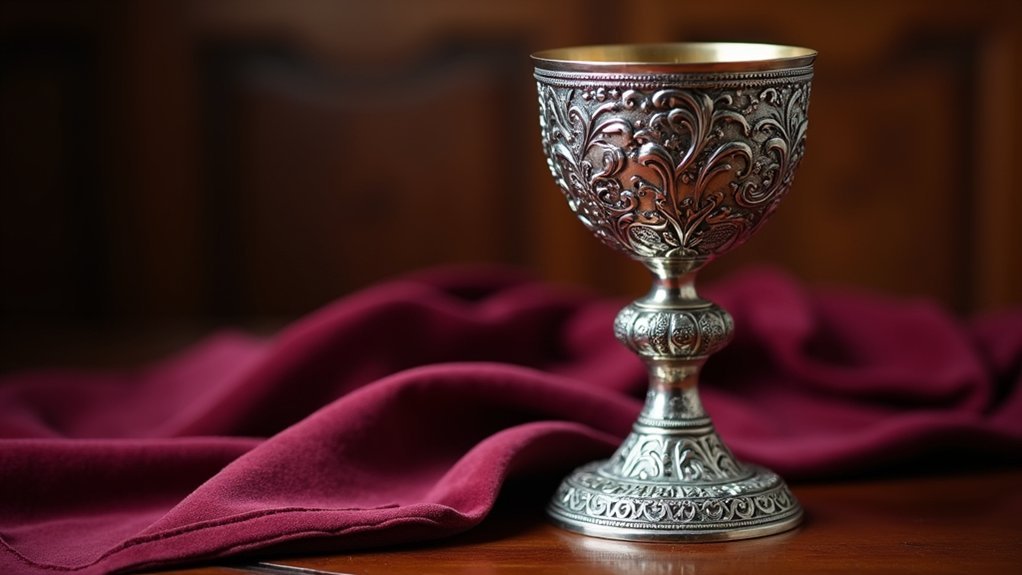
When you’re dealing with high-value silver handcrafts, you’ll need to select appraisers who specialize in antique silver and understand current market dynamics.
You should verify your chosen professional provides proper documentation and certification that meets insurance or legal requirements.
You’ll also want to take into account market timing, as silver values fluctuate based on precious metal prices and collector demand cycles.
Choosing Qualified Appraisers
How do you guarantee your valuable silver handcraft receives an accurate professional appraisal? Selecting qualified appraisers directly impacts the value of your antique assessment.
You’ll need professionals who understand silver craftsmanship intricacies and market dynamics.
When choosing appraisers, prioritize these essential qualifications:
- Professional Credentials – Verify certification from recognized organizations like the American Society of Appraisers (ASA) or International Society of Appraisers (ISA).
- Silver Expertise – Confirm specific experience with silver antiques and handcrafts rather than general appraisal knowledge.
- USPAP Compliance – Ascertain they follow Uniform Standards of Professional Appraisal Practice for ethical standards.
- Proven Track Record – Request client references and reviews from previous high-value silver appraisals.
Choose appraisers who provide thorough written reports with photographs and detailed descriptions, enhancing your item’s documentation and future resale potential.
Documentation and Certification
After securing your qualified appraiser, you’ll need extensive documentation and certification to maximize your silver handcraft’s assessed value.
Gather all available provenance materials, including original receipts, purchase records, and previous appraisals. Photographs showing the piece’s condition over time strengthen authenticity claims and support historical importance.
Your appraiser will provide written certification using industry-standard methods and tools, ensuring accurate market valuations. This documentation becomes essential for insurance purposes, creating a clear record of worth for potential loss or damage claims.
Specialist appraisers focusing on specific silver types can uncover unique characteristics that enhance value through their expert certification. Complete documentation packages greatly boost buyer confidence and support authenticity claims for high-value pieces.
Market Timing Strategies
Why should professional appraisals guide your selling decisions for high-value silver handcrafts?
Professional evaluations provide essential market insights that’ll maximize your returns through strategic timing. Appraisers understand fluctuating silver prices and current collector demand patterns, giving you competitive advantages in volatile markets.
Effective market timing strategies include:
- Track daily silver price fluctuations to identify peak selling opportunities
- Consult multiple appraisers for diverse market perspectives and valuation ranges
- Leverage appraiser insights into auction house trends and collector preferences
- Document authenticity through professional reports to attract serious buyers and justify premium pricing
Your appraisal report becomes a powerful selling tool, documenting craftsmanship quality, historical significance, and provenance.
This documentation enhances resale value by providing buyers with confidence in authenticity and unique features, ultimately commanding higher prices in competitive markets.
Frequently Asked Questions
How Can You Tell if Silver Is Worth Anything?
You’ll know silver’s valuable by checking hallmarks like “925,” weighing it for melt value, examining craftsmanship quality, evaluating its condition, and researching comparable pieces online or consulting professionals.
How to Price Silver Items?
Start by weighing your silver piece and calculating its melt value using current market prices. Then assess craftsmanship quality, condition, maker’s marks, and compare with similar sold items to determine final pricing.
How to Determine the Value of Silver?
You’ll determine silver’s value by checking its purity hallmark, weighing it in troy ounces, researching current spot prices, calculating melt value, then considering craftsmanship, historical significance, and condition factors.
How to Determine the Value of a Silver Platter?
Check your platter’s hallmark stamps for purity, weigh it precisely, assess its condition for damage, research comparable pieces online, and consider its craftsmanship, age, and historical significance beyond silver content.
In Summary
You’ll find that valuing authentic silver handcrafts requires careful examination of multiple factors working together. Don’t rely on just one element—combine purity marks, craftsmanship quality, condition, age, and market comparisons to reach an accurate assessment. Remember that provenance can greatly impact value, and when you’re dealing with potentially high-value pieces, you shouldn’t hesitate to seek professional appraisal services for confirmation and insurance purposes.

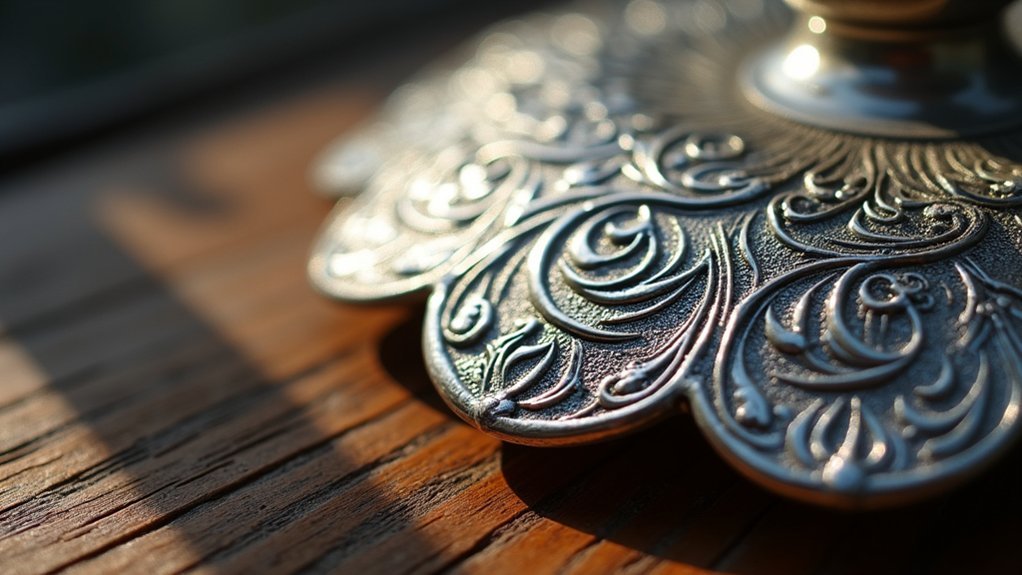



Leave a Reply